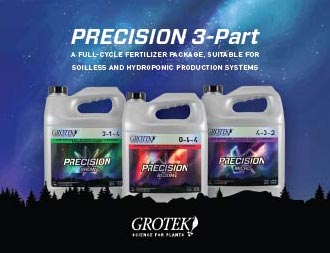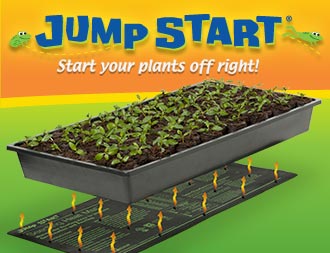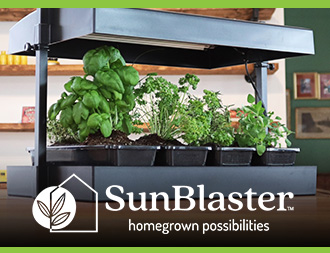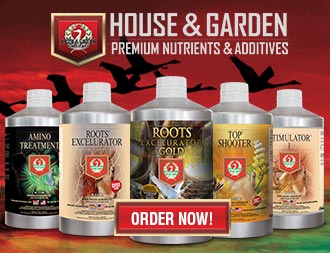I first began to grow herbs hydroponically about 40 years ago. But I didn't notice a demand for fresh herbs by grocery stores and gourmet restaurants until the past 10 years. Cooks and gardeners in the average home are consuming and growing herbs more each year. With this rising interest worldwide, the demand for hydroponically grown herbs has also increased.
Hydroponic herbs are popular because of their fine quality and stronger flavor and oils. For example, a test done in Minnesota showed that hydroponically grown basil prepared for flash freezing had a 40% increase in flavor compared with field-grown basil. These kind of results encouraged me to take more interest in the commercial production of culinary, medicinal, and cosmetic herbs, and I recommend that my clients look into the feasibility of growing herbs as a commercial crop. The growers who took my advice are showing a better profit margin that if they grew other conventional hydroponic crops.
If you are thinking seriously about growing herbs, find out what is selling in your market area. Ask your friends, family, and neighbors which herbs they like and use. There is no point growing it unless you can sell it! Visit the supermarkets in the area you wish to sell: check the produce shelves and talk to the produce manager. He or she can tell you what herbs the store will sell, what is in highest demand, which ones are most difficult to obtain, and those that are usually thrown away. At the same time, you can see what type of packaging that other growers or the store is currently using. Ask if the produce manager would prefer a different style of bag or box that might help present and sell the product better. Some buyers prefer plastic freezer bag, clear clamshell boxes, or the "fresh" look in open bunches.
Most supermarkets have fixed ideas about packaging, for safety and aesthetic reasons. Remember, the more sophisticated the packaging, the more labor-intensive and expensive it becomes. For example, the plastic freezer bag costs less than one cent, whereas clamshell boxes can cost as much as 20 cents each, depending on the volume ordered.
 |
Once you have done your market research, you should have a good idea of what to grow and how much you will need of each herb to supply your customer with a steady supply. When I first started to grow with a 6,000 ft2 greenhouse, I first visited the buyer of a large grocery chain. He said he loved my product and would like eight cases per week for each of the more than 300 stores inhis south-east region. I would need to provide him with 2,400 cases every week! I was only producing about half that much and could not meet his expectations. I therefore had to find a smaller chain until I could expand my greenhouse to fulfill the needs of the larger chain stores. The point is that you must be able to provide a constant and reliable supply to meet the requests of your customers. The buyer will not give you space if you cannot produce regularly.
When planning this project, leave enough in your budget for items such as display racks and promotion. Many start-up operations forget to include UPC codes and liability insurance (which most supermarkets require before they will purchase produce).
In my opinion, the foundation for a hydroponic growing system should be 12-in.-long roof pans. I use aluminum pans covered with enamel. After using them for longer than 10 years, I have seen little deterioration or corrosion. They lock together and make a beautiful 4-ft bench. I have connected them to as long as 30 ft. I fill their 2-in. depth with coarse-grade perlite, and set the trays on supports with a 4-in. gentle slope along 24 ft. for the nutrient to run.
The nutrient is fed by a dripper at one end and drains at the other end back to the reservoir. The reservoir is a 1,000-gal. septic tank set 1-in. above ground level, which prevents runoff into the tank. I recommend using a 1-HP shallow-well pump, which is large enough to supply a 20,000 ft2 greenhouse. If you are in a tropical area, you will need a chiller aerator to keep the nutrient temperature down. The nutrient is kept at an EC level of 2,000 and pH 6.8. All herbs that I have grown thrive at these levels. I have also grown herbs in my home system, which is a small 12-ft.-long unit.
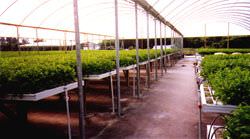 Many herbs, such as basil, mint, oregano, and marjoram, can be cut frequently and re-grow quickly. Basil, for example, will grow back in about 12 days depending on the light and temperature. Here in the southern part of the United States, basil grows very quickly, whereas in the north where it is colder during the winter months, it takes much longer. Other herbs such as arugula and cilantro will re-grow, but I have found it quicker to re-seed them. The output of herbs in this system varies with the climatic conditions. For example, I have grown as much as 1 1/2 lb. per month per square foot of basil, but I prefer to limit it to about = or < -1 lb. per square foot.
Many herbs, such as basil, mint, oregano, and marjoram, can be cut frequently and re-grow quickly. Basil, for example, will grow back in about 12 days depending on the light and temperature. Here in the southern part of the United States, basil grows very quickly, whereas in the north where it is colder during the winter months, it takes much longer. Other herbs such as arugula and cilantro will re-grow, but I have found it quicker to re-seed them. The output of herbs in this system varies with the climatic conditions. For example, I have grown as much as 1 1/2 lb. per month per square foot of basil, but I prefer to limit it to about = or < -1 lb. per square foot.
With herbs, pesticide use can and should be kept at a minimum. A good preventative, such as insecticidal soap, will usually keep most pests under control. Sticky traps should be used for indicators of what is present in your greenhouse or home unit. Indoors, herbs tend to be attractive to aphids and whiteflies.
As more and larger commercial greenhouses are put into production, the feasibility of growing pharmaceutical and cosmetic herbs increases. Most companies who buy herbs require huge volumes and prefer those grown in a controlled environment because of their purity, cleanliness, and the extra oils present.
In closing, I cannot emphasize enough the importance of conducting background and market research before you jump into growing any hydroponic crop commercially. For those who are already cultivation hydroponic herbs and are experimenting with growing the hundreds of herbs available today, we would love to hear about your experiences.
Gordon Creaser is a regular columnist for The Growing EDGE and a professional hydroponics consultant. He has been involved in hydroponic system construction and food production for more than 40 years. Dr. Creaser recently joined Aquatic Eco- Systems, Inc., as Technical Director of their new Hydroponic Division. Aquatic Eco- Systems is the largest aquaculture equipment distributor worldwide, with more than 50 employees and 19 years of operation. The Hydroponic Division was formed in response to increasing interest in growing vegetables and fish together, called aquaponics.
Growing EDGE, Volume 8, Number 3, Spring 1997
Reprinted by permission.

